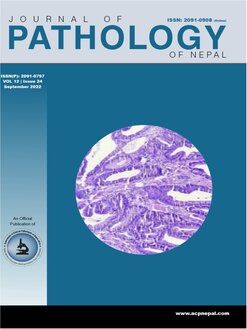Scope of mean neutrophil volume as an indicator of neonatal sepsis
DOI:
https://doi.org/10.3126/jpn.v12i2.43997Keywords:
Inflammation; Mean neutrophil volume; Neonatal sepsis; Sepsis;Abstract
Background: Neonatal sepsis is one of the leading causes of mortality in developing countries because of its non-specific presentation. Blood culture is the gold standard for diagnosing sepsis, but culture results take 48 – 72 hours. Therefore, there is a need for an indicator that could be used as a simple parameter to indicate the possibility of evolving sepsis to the clinician. The efficacy of mean neutrophil volume as an indicator must be evaluated.
Materials and methods: The study aims to evaluate the utility of the mean neutrophil volume in the early diagnosis of neonatal sepsis. Following ethical clearance, the study involved analyzing mean neutrophil volume from peripheral smears of 50 newborns clinically diagnosed with neonatal sepsis. The control group included mean neutrophil volume findings from peripheral smears of normal newborns. Maternal or fetal factors like pregnancy-induced hypertension and birth asphyxia that could cause changes in neutrophils were excluded. The mean neutrophil value was calculated after establishing the mean diameter of 100 neutrophils per case using the National Institutes of Health Image J software.
Results: The average mean neutrophil volume was found to be significantly increased in the sepsis group (181x104fl) than in the control group (739x103fl). A statistically significant difference (p= < 0.0001) in the mean neutrophil volume was observed.
Conclusions: Mean neutrophil volume is a potential indicator to distinguish neonates with and without sepsis and help clinicians in the early diagnosis and management of sepsis.
Downloads
Downloads
Published
How to Cite
Issue
Section
License
Copyright (c) 2022 Chaitra B E, Raja Parthiban, Shilpa G, Indrani Krishnappa, Impana Gowda

This work is licensed under a Creative Commons Attribution 4.0 International License.
This license enables reusers to distribute, remix, adapt, and build upon the material in any medium or format, so long as attribution is given to the creator. The license allows for commercial use.




